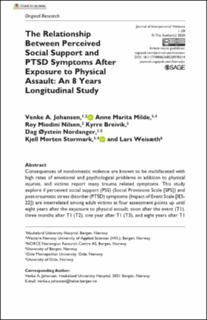| dc.contributor.author | Johansen, Venke A | |
| dc.contributor.author | Milde, Anne Marita | |
| dc.contributor.author | Nilsen, Roy Miodini | |
| dc.contributor.author | Breivik, Kyrre | |
| dc.contributor.author | Nordanger, Dag | |
| dc.contributor.author | Stormark, Kjell Morten | |
| dc.contributor.author | Weisæth, Lars | |
| dc.date.accessioned | 2020-12-22T12:04:23Z | |
| dc.date.available | 2020-12-22T12:04:23Z | |
| dc.date.created | 2020-11-19T13:20:55Z | |
| dc.date.issued | 2020 | |
| dc.identifier.citation | Johansen, V. A., Milde, A. M., Nilsen, R. M., Breivik, K., Nordanger, D. Ø., Stormark, K. M., & Weisæth, L. (2020). The Relationship Between Perceived Social Support and PTSD Symptoms After Exposure to Physical Assault: An 8 Years Longitudinal Study. Journal of Interpersonal Violence. | en_US |
| dc.identifier.issn | 0886-2605 | |
| dc.identifier.uri | https://hdl.handle.net/11250/2720777 | |
| dc.description.abstract | Consequences of nondomestic violence are known to be multifaceted with high rates of emotional and psychological problems in addition to physical injuries, and victims report many trauma related symptoms. This study explore if perceived social support (PSS) (Social Provisions Scale [SPS]) and post-traumatic stress disorder (PTSD) symptoms (Impact of Event Scale [IES-22]) are interrelated among adult victims at four assessment points up until eight years after the exposure to physical assault; soon after the event (T1), three months after T1 (T2), one year after T1 (T3), and eight years after T1 (T4). One hundred and forty-three subjects participated at T1, 94 at T2, 73 at T3, and 47 accepted a follow-up at T4. At T1, 138 of 143 completed the questionnaires within 16 weeks after the incident. PTSD symptoms were highly correlated across time (p < .001); PSS were significantly correlated only between T1 and T2 (p < .001), T1 and T3 (p < .05), and between T2 and T3 (p < .05). Cross-lagged analyses showed an inverse relationship between prior PSS and later PTSD symptoms across all time points (ps < .05); not proved between prior PTSD symptoms and later PSS (ps > .1). PSS at T1 was an independent predictor of PSS one year and eight years after the incident. We conclude that higher perception of social support protects against the development of PTSD symptoms; diminished perception of social support increases the risk of developing PTSD symptoms. These findings suggest that PSS after experiencing a violent assault should be considered as an important factor in natural recovery in the long run, as well as essential alongside psychiatric treatment. Establishing psychosocial interventions for victims of physical violence in the acute phase may prevent prolonged trauma reactions. | en_US |
| dc.language.iso | eng | en_US |
| dc.rights | Navngivelse 4.0 Internasjonal | * |
| dc.rights.uri | http://creativecommons.org/licenses/by/4.0/deed.no | * |
| dc.subject | perceived social support | en_US |
| dc.subject | PTSD | en_US |
| dc.subject | physical assault | en_US |
| dc.subject | cross-lagged | en_US |
| dc.subject | longitudinal | en_US |
| dc.subject | nondomestic violence | en_US |
| dc.title | The relationship between perceived social support and PTSD symptoms after exposure to physical assault: An 8 years longitudinal study | en_US |
| dc.type | Peer reviewed | en_US |
| dc.type | Journal article | en_US |
| dc.description.version | publishedVersion | en_US |
| dc.rights.holder | © The Author(s) 2020 | en_US |
| dc.source.pagenumber | 1-28 | en_US |
| dc.source.journal | Journal of Interpersonal Violence | en_US |
| dc.identifier.doi | 10.1177/0886260520970314 | |
| dc.identifier.cristin | 1849880 | |
| cristin.ispublished | true | |
| cristin.fulltext | original | |
| cristin.qualitycode | 1 | |

